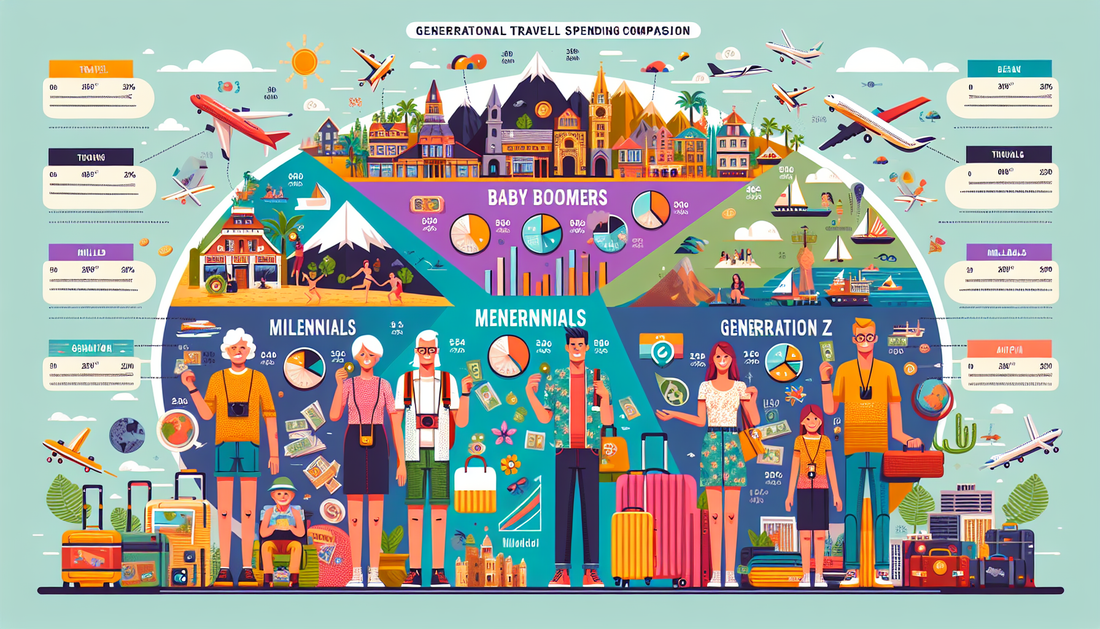
Generational Differences in Travel Spending: Insights for 2023
WonderLust3.6 RecipesShare
As the world continues to rebound from the pandemic, travel spending trends in 2023 reveal striking generational differences that brands need to consider. While Generation Z and Millennials prioritize experiences and sustainability, Baby Boomers lean towards comfort and luxury. Understanding these preferences can guide businesses in crafting tailored services and marketing strategies.
- Generation Z (ages 18-26) is set to prioritize budget travel, focusing on experiences like adventure trips and environmental sustainability 🌍.
- Millennials (ages 27-42) are expected to spend more on luxury accommodations and unique experiences, such as wellness retreats and culinary tourism 🍽️.
- Generation X (ages 43-58) seeks a balance of comfort and value, often opting for family-oriented vacations that include multiple generations 🏖️.
- Baby Boomers (ages 59-77) are likely to invest heavily in luxurious cruises and resort stays, valuing relaxation and high-end amenities 🛳️.
Travel agencies and brands must adapt their marketing strategies to cater to these diverse preferences, ensuring they meet the demands of each generation effectively in 2023.
Generational travel spending has become an intriguing subject as different age groups exhibit varying spending habits and preferences. The love for travel spans across generations, but how each generation approaches travel finances varies significantly. Analyzing these differences gives insight into the evolving landscape of travel, especially as we move through 2023.
Millennials, often dubbed the "experience generation," have opened new avenues for travel. They tend to prioritize spending on experiences, sometimes at the expense of saving for a house. According to recent studies, Millennials allocate a significant portion of their disposable income towards travel. This focus on travel aligns with their desire for new experiences, which they often share on social media platforms.
Meanwhile, Generation X, who are now in their 40s and 50s, often strike a balance between travel and savings. This generation is more likely to plan family vacations, emphasizing the importance of shared experiences. While they do spend on travel, they often do so with one eye on their financial future, making strategic travel choices to fit their budgets.
Travel Spending Trends Among Generations
Understanding the nuances of generational travel spending is essential. Baby Boomers, aged between 59 and 77, often have the most disposable income available for travel. They tend to spend significantly on luxury travel, often opting for packages that offer comfort and convenience. This demographic enjoys experiential travel, including cruising and guided tours, as they seek relaxation and exploration.
Research indicates a noticeable shift in travel priorities over the past decade. For instance, Millennials have paid for their travels by utilizing travel reward programs. They frequently take advantage of credit rewards, allowing them to go on multiple trips a year. In contrast, Baby Boomers are more traditional in their approach, often preferring straightforward cash purchases without reliance on credit.
The Influence of Technology on Travel Spending
Technology plays a vital role in how each generation plans their travels. Millennials are tech-savvy. They utilize apps and online resources to find the best deals, compare destinations, and book experiences. In contrast, Baby Boomers may rely more on travel agents or traditional booking methods. This divergence highlights the importance of digital marketing strategies that cater to different audiences.
Furthermore, social media has become a powerful tool for the younger generations. Travel influencers on platforms like Instagram encourage a culture of exploration and spending. This outreach effectively shapes travel choices, leading many Millennials to prioritize Instagram-worthy destinations, from the pristine beaches of Bali to the breathtaking fjords of Norway.
Destination Preferences Across Generations
Different generations also show varied preferences for destinations. Millennials often choose vibrant cities and adventure tourism spots. Popular locations include Amsterdam, Tokyo, and various Southeast Asian countries offering affordable yet exhilarating experiences. This demographic enjoys blending urban exploration with nature, often seeking hiking opportunities in national parks.
On the other hand, Baby Boomers typically gravitate towards destinations rich in culture and history. Locations such as Rome, Paris, and Athens appeal to this generation's desire for educational travel experiences. They often participate in guided tours that enhance their understanding of the sites they visit, reflecting their appreciation for history and culture.
Impact of Global Events on Travel Spending
The pandemic has had a profound impact on travel habits and spending patterns. In the wake of COVID-19, many people across all generations have reassessed their travel priorities. While younger travelers are returning to travel faster than older generations, Boomers have become more cautious. This shift has altered the landscape of travel spending.
As travel restrictions ease, Millennials express a greater eagerness to travel again, prioritizing wellness and outdoor experiences. Meanwhile, Boomers tend to be more selective, sometimes opting for local travel experiences to minimize health risks. This cautious approach often results in extensive planning, focusing on safety and comfort during their journeys.
Financial Planning for Travel Across Generations
Budgeting for travel is crucial for every generation. Millennials often lean towards budget platforms like Airbnb and hostels, while Baby Boomers are more inclined to choose hotels that offer amenities creating a balance between comfort and cost. Various online travel agencies cater to these preferences, allowing travelers to customize their experiences.
Additionally, financial advisors recommend establishing a travel fund. This recommendation resonates across generational lines, as individuals plan vacations. Setting aside money specifically for travel helps alleviate financial stress and allows for spontaneous trips. This strategy echoes the sentiment shared across generations: travel should be enjoyable, not a financial burden.
The Future of Generational Travel Spending
As we look to the future, generational differences in travel spending will likely continue to evolve. The continued rise of remote work may influence travel patterns, allowing younger generations to travel more frequently. This flexibility will enable a surge in digital nomadism, where work and travel blend seamlessly.
Baby Boomers will likely embrace moderate spending habits, focusing on quality experiences rather than fleeting ones. As they age, this generation may prioritize destinations that offer rich cultural engagements and comfort, ensuring their travel experiences are fulfilling and enjoyable.
Conclusion: The Landscape of Travel Spending
The generational divide in travel spending reveals that preferences and priorities differ widely. Millennials thrive on experiences and social validation, while Baby Boomers value comfort and cultural enrichment. As travel trends shift, understanding these dynamics is essential for businesses in the travel industry to cater effectively to diverse travelers.
In conclusion, generational travel spending patterns offer insights into how different age groups prioritize travel experiences and finances. As travel continues to evolve, the key for businesses will lie in adapting to these changing preferences, ensuring that every generation feels valued in the travel market.











